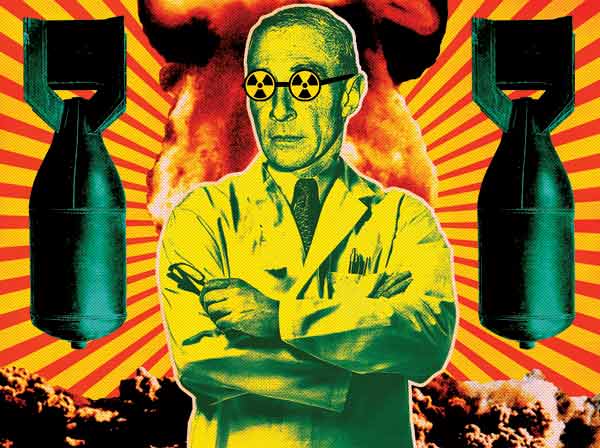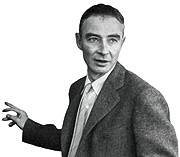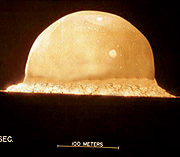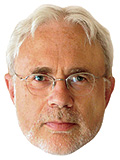
In 1959, a British intellectual named C. P. Snow delivered what would become a seminal lecture. From a podium at Cambridge, Snow let loose on the world the concept of “the two cultures”—or the sharp divide between art and science. “Between the two—a gulf of mutual incomprehension,” he said. “Sometimes (particularly among the young) hostility and dislike, but most of all lack of understanding.”
Into this gulf plunges Doctor Atomic, a new opera that would have stimulated Snow—both a practical physicist and an aspiring novelist. The critically acclaimed work, which has its Chicago première at Lyric Opera December 14th, tells a story that takes place largely around one day: the day leading up to the testing of the first atomic bomb in 1945. Springing from a watershed moment in Chicago history (see timeline below) and based on real events, the opera is the result of a collaboration between Pulitzer Prize–winning composer John Adams and MacArthur Foundation grant-winning director Peter Sellars, whose previous two operas together, Nixon in China and The Death of Klinghoffer, are also based on recent history.
How factual is it? Adams and Sellars constructed the libretto of Doctor Atomic out of diaries, memoranda, textbooks, and other archival materials. Even the poems used in arias have a connection to history—the John Donne sonnet that gave the New Mexico outpost its name, Trinity, makes it into song. In fact, Professor Snow’s brain would swim with some of the unlikely-for-opera passages, like a description—set to music—of the placement of detonators on the bomb, the result of the interweaving of a dodecahedron and an icosahedron.
With jargon like this in the libretto, it’s not surprising that Adams doesn’t see such a wide gulf between science and the art that reflects it. “I’m aware of Snow’s dichotomy, and I just don’t feel it,” Adams says. “The tension in culture is between market forces and artistic and scientific endeavor. I see myself aligned with pure scientists. We’re both trying to express the human condition.” Sellars agrees—and points to ancient philosophers like Pythagoras, who mined both music and metaphysics. “There’s an absolute lust of each side to engage with the other,” he says.
Far from pure science, Doctor Atomic focuses on the moral issue of the bomb. “These aren’t just laws of the universe. These are human beings,” says Sellars. “Science is human beings.” Human beings such as J. Robert Oppenheimer, the opera’s main character, who was famously a lover of poetry. He said he thought of a line from the Bhagavad-Gita while pondering the import of the first bomb blast: “Now I am become Death, the destroyer of worlds.”
Or such as Edward Teller, the Hungarian-born physicist said to be the model for Dr. Strangelove. Adams mentions the first thing Teller did when he arrived in the remote New Mexico desert: “arrange to have a piano delivered to his little house, so that when he got back from a really long, arduous day in the lab, he could play Mozart sonatas and Bach fugues.”
Imagine, then, the reactions of Oppenheimer and Teller if they had been at the preview of Doctor Atomic in San Francisco in 2005. A physicist who was in attendance objected to the opening lines: “Matter can be neither created nor destroyed but only altered in form / Energy can be neither created nor destroyed but only altered in form.” He complained that the remark reflects a pre-Einsteinian view of physics. Physicists now know that matter can be converted into energy—in fact, this is what makes the bomb possible. Adams has since revised the lines to be scientifically accurate.
That hiccup aside, Sellars’s and Adams’s personal experience suggests a happy marriage of art and science. As Sellars points out, it’s no accident that scientists love music. In fact, when Adams was in Chicago to conduct the CSO several years ago, an astrophysicist friend of his took him to Fermilab. When they arrived, a physicist with a whole stack of Adams’s CDs was waiting there for autographs, like a teenager at a movie première standing behind the velvet rope.
Illustration: Sean McCabe
A Bomb Inspires an Opera
From pure physics to entertainment
 December 1942
December 1942
A team of University of Chicago scientists, led by Enrico Fermi, mounts the first successful atomic chain reaction in a squash court under the stands of Stagg Field in Hyde Park.
March 1943
The Manhattan Project opens a research lab in New Mexico under the direction of J. Robert Oppenheimer (right), a physics professor. “Oppenheimer was a reader of poetry,” composer John Adams says. “He carried in his back pocket a volume of Baudelaire in French.”
 July 1945
July 1945
The first atomic bomb (left) is successfully detonated in the New Mexico desert.
November 1999
What starts as an idea for a Faust-like opera about the Manhattan Project changes when Adams (below right) signs on. “The [classic] Faust was one of extreme arrogance,” Adams says. “[The project scientists] were convinced that they were in a race against the Nazis to save civilization.”
 October 2005
October 2005
Adams’s opera, Doctor Atomic, premières in San Francisco. The New York Times calls it Adams’s “most inventive and emotional score to date.”
December 2007
The Chicago production is scheduled to open with a new scene for Kitty Oppenheimer, Robert’s wife, just before the final countdown. “Everybody seemed to feel she’s such an important voice—I suppose you could call it the feminine conscience,” Adams says.
Photography: (Oppenheimer and explosion) Courtesy of Department of Energy, (Adams) Deborah O’Grady


